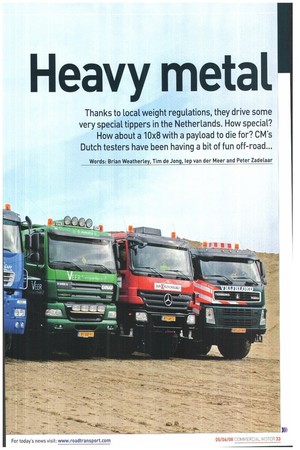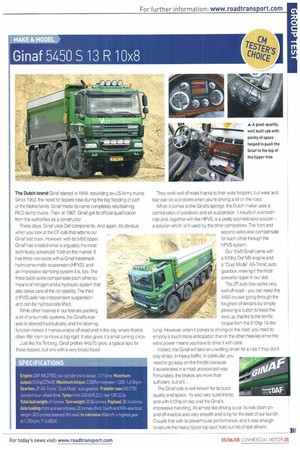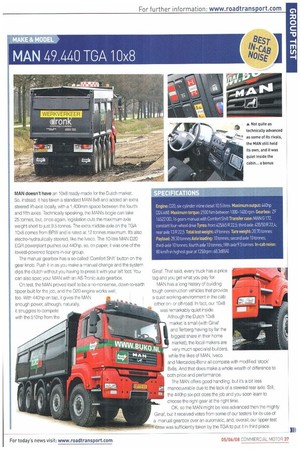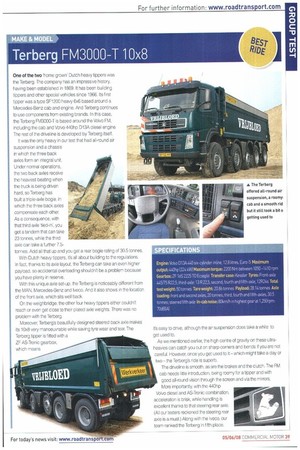Heavy metal
Page 33

Page 34

Page 35

Page 36

Page 37

Page 38

Page 39

If you've noticed an error in this article please click here to report it so we can fix it.
Thanks to local weight regulations, they drive some very special tippers in the Netherlands. How special? How about a 10x8 with a payload to die for? CM's Dutch testers have been having a bit of fun off-road...
Words: Brian Weatherley, Tim de Jong, lep van der Meer and Peter Zadelaar
They do things differently in the Netherlands, especially when it comes to local construction and use regulations for 'heavy' tippers that work off-road on construction sites. And when we say 'heavy', that's exactly what we mean.
In the Netherlands, local laws allow a 10x8 tipper to run at a total gross vehicle weight (including payload) of 50 metric tonnes (or 18 tonnes more than a normal 8x4 in the UK). This strange anomaly is unique to the Netherlands, you won't find it anywhere else in Europe, so local importers and manufacturers have responded to the situation by building their own heavy tippers for the job.
To see how a bunch of five-axle tippers perform, we asked CM'S Dutch transport colleagues to put together a special test, and they came up with no less than five of them, which they promptly put through their paces.
Our five-axle contenders consisted of two 'home grown' 10x8s from the factories of specialist manufacturers Ginaf and Terberg. The two Dutch truck constructors use driveline components and cabs from Daf and Volvo, hut on their own chassis and come complete with special suspension systems. But where these two local boys once ruled supreme in the heavy tipper market, these days, others such as MAN and Mercedes-Benz have also dipped their proverbial toes into the water, building their own five-axle construction specials. And finally, the Iveco in the test came with an extra fifth axle fitted at the Schouten lveco dealership.
In each case, we're talking about a four-axle 8x8 rigid with an extra steered axle in the middle — there to make sure axle loadings remain in the legal limit. Once you lift the extra axle on-site, what remains is basic 8x8. Thus, the 10x8 configuration is only there to save you from being booked every time you have to report to weighbridge or pass over the Dutch WIMS (weigh in motion system) scales sunk into the surface of many major Dutch roads.
The two Dutch brands, Terberg and Ginaf, both have steering axles right at the back, as does the MAN, with the conversion carried out by one of the German truck-maker's dealers in Holland. Thanks to this steered and driven wide-spread-bogie, these trucks are easier to handle both onand offroad. They also have a much higher payload than a typical eight-legger because of that bogie.
My, how things have changed... Nowadays, tippers hardly drive through thick mud or deep sand on construction sites. Usually, there's always a solid surface, or man-made steel plates to drive on so you don't need to engage drive on the front axle. However, once in a while, the surface is bad enough for you to have to engage drive to eight axles, and a 10x8 configuration can plough through rough terrain. The extra driven axles are activated by switches on the dash.
Of course, there's nothing quite like A Loading up. A tipper's experience, and a driver needs to know when and where role is to move a load as to call on that extra traction. And it's not just off-road.
swiftly and as hassle-free You need to know how to drive these heavies downtown as possible. Let testing and on the motorway, which requires almost as much skill.
commence... A 10x8 is a big lump, and with 50 tonnes on the road, you soon learn to drive defensively, not least because it takes a while to turn one of them around.
Our test circuit included off-road terrain as well as the open road. And although four of the trucks were equipped with 440hp engines (one even had 510hp on tap), you really need to apply that horsepower carefully. Too much power and you go all over the place. Too little and you end up stalling. Fortunately, some of our heavy hitters came with an automatic box, which always helps. In fact, even on tipper work, we don't think it will be long before the latest generation of smart-thinking autos replaces the tried-and-trusty manual box. Finally, having driven our quintet, CM's panel of experienced drivers came up with their own preferences and final choice.
The Dutch brand Ginaf started in 1948, rebuilding ex-US Army trucks. Since 1953, the need for tippers rose during the big flooding of part of the Netherlands, Ginaf made its name completely refurbishing REO dump trucks. Then, in 1967, Ginaf got its official qualification from the authorities as a constructor.
These days, Ginaf uses Daf components. And again, ifs obvious when you look at the CF cab that adorns our Ginaf test truck. However, with its 5450 tipper, Ginaf has created what is arguably the most technically advanced 10x8 on the market. It has three rear-axles with a Ginaf trademark hydra-pneumatic suspension (HPVS), and an impressive damping system it is, too. The three back-axles compensate each other by means of nitrogen and a hydraulic system that also takes care of the roll stability. The third (HPVS) axle has independent suspension and can be hydraulically lifted.
While other heavies in our test are packing a lot of pneumatic systems, the Ginaf's rearaxle is steered hydraulically, and the steering function makes it manoeuvrable off-road and in the city, where there's often little room to move a big rigid. It also gives it a small turning circle.
Just like the Terberg, Ginaf prefers 445/75 tyres, a typical size for these tippers, but one with a very broad tread. They work well off-road thanks to their wide footprint, but wear and tear can be a problem when you're driving a lot on the road.
When it comes to the Ginaf's springs, the Dutch maker uses a combination of parabolic and air suspension. It results in a smooth ride and, together with the HPVS, is a pretty sophisticated solution a solution which isn't used by the other competitors. The front and second axles also compensate for each other through the HPVS system.
Our 10x8 Ginaf came with a 510hp Oaf MX engine and a "Dual Mode" AS-Tronic auto gearbox, making it the most powerful tipper in our test.
The 7F auto box works very well off-road you can keep the 5450 bruiser going through the toughest of terrains by simply pressing a button to keep the revs up, thanks to the terrific torque from the 510hp 13-litre lump. However, when it comes to driving on the road, you need to employ a touch more anticipation than in the other heavies since the extra power means you have to drive it with care.
Indeed, the Ginaf will take an unwitting driver for a ride if they don't stay sharp. In heavy traffic, in particular, you need to go easy on the throttle because it accelerates in a most unexpected way. Fortunately, the brakes are more than sufficient, but still...
The Ginaf cab is well-known for its build quality and space. It's also very quiet inside, and with 510hp on tap and the Ginafs impressive handling, it's almost like driving a car. Its ride (both onand off-road) is also very smooth and is by far the best of our bunch. Couple that with its powerhouse performance, and it was enough to secure the heavy tipper top spot from our trio of test drivers.
MAKE & MODEL
Iveco Eurotrakker 10x8
This robust Italian Stallion' is very much a basic working tool that will appeal to those drivers who love gear-shifting and working their way through the 16 ratios in the ZF gearbox. Some drivers call the lveco "a truck with character". We'd say that the Eurotrakker is a 'no-thrills, no-frills' truck that you'll either love or loathe.
Similar to MAN, Iveco doesn't sell a ready-made 10x8 straight from the box, So. just as with the TGA, Iveco takes an 8x8 and turns it into a 10-wheeler. The Eurotrakker's fourth and fifth axles are positioned fairly close, which isn't the best configuration because it limits the payload.
In theory, the lveco's bogie can take 32 tonnes, but local axle-loading regs spoil things. In reality, the set-up is restricted to two times 9.5 tonnes, which gives 19 tonnes in total.
Iveco also fits its 10x8 with relatively narrow tyres, although customers can spec 'wideboys' if they want. The Trakker's powerful Cursor 13 straight-six delivers 450hp, and, like we said before, when you've got that power and the ZF Ecosplit manual box to play with, you end up using just about all the ratios and splits in the double H-pattern box. It's slick to use and smooth, and, after an increasing number of autobox trucks to test, the big Italian rigid was fun to drive.
Indeed, our Dutch testers ended up preferring the 16-speed manual over a 12-speed automatic. We're not sure we would, though.
There's no doubt that some tipper drivers still prefer a manual box when driving off-road because it allows them to react quicker to the driving conditions. It's the same with air suspension. You get less feeling of what's happening at ground level with air than with parabolic or leaf-spring suspension whether you are onor off-road. The Iveco chassis set-up is pretty conventional, with parabolics on the front and leaf springs on the rear axles. The cab layout is also rather out of step with its rivals. However, this was because it had the old Trakker interior as opposed to the latest Stralis cabin. Consequently, even the switches in the cab look a bit old-fashioned and a bit vulnerable.
There's one benefit of having the old trim it's easy to clean. That's a big plus considering the dirty job these trucks do. In the end, though, the Iveco came fourth, although, to be fair, the differences in scores between our test quintet weren't that pronounced. Ultimately, they all proved big and strong and, above all else, fun to drive.
MAKE & MODEL
MAN 49.440 TGA 10x8
MAN doesn't have an 10x8 ready-made for the Dutch market. So, instead, it has taken a standard MAN 8x8 and added an extra steered lift-axle locally, with a 1,400mm space between the fourth and fifth axles. Technically speaking, the MAN's bogie can take 25 tonnes, but, once again, legislation cuts the maximum axle weight short to just 9.5 tonnes. The extra middle-axle on the TGA 10x8 comes from BPW and is rated at 12 tonnes maximum. It's also electro-hydraulically steered, like the lveco. The 10-litre MAN D20 EGA powerplant pushes out 440hp, so, on paper, it was one of the lowest-powered tippers in our group.
The manual gearbox has a so-called 'Comfort Shift' button on the gear knob. Push it in as you make a manual change and the system dips the clutch without you having to press it with your left foot. You can also spec your MAN with an AS-Tronic auto gearbox.
On test, the MAN proved itself to be a no-nonsense, down-to-earth tipper built for the job, and the 020 engine works well, too. With 440hp on tap, it gives the MAN • enough power, although, naturally, it struggles to compete with the 510hp from the Ginaf. That said, every truck has a price tag and you get what you pay for.
MAN has a long history of building tough construction vehicles that provide a quiet working environment in the cab either onor off-road. In fact, our 10x8 was remarkably quiet inside. Although the Dutch 10x8 market is small (with Ginaf and Terberg having by far the biggest share in their home market), the local makers are very much specialist builders, while the likes of MAN, Iveco and Mercedes-Benz all compete with modified 'stock' 8x8s. And that does make a whole wealth of difference to both price and performance.
The MAN offers good handling, but it's a bit less manoeuvrable due to the lack of a steered rear axle. Still, the 440hp six-pot does the job and you soon learn to choose the right gear at the right time.
OK, so the MAN might be less advanced then the mighty Ginaf, but It received votes from some of our testers for its use of a manual gearbox over an automatic, and, overall, our tipper test rew was sufficiently taken by the TGA to put it in third place.
MAKE &MODEL
Mercedes-Benz Actros 5044 AK 10)(8
This sturdy 1 Ox8 tipper horn Mercedes-Benz offers good driving and handling, both onand off-road. In short, it's a Mere through and through. However, the old-style Telligent shifter is basically a manual box with a pre-select function, so you still have to depress the clutch when you change gear or you will come to a stop. This means when you drive the Mere you have to remember you're not driving a full auto.
Gear-changing is handled by means of flippers on the steering column the Merc box is a bit slow, and if you try to rush when changing gear and lift your foot off the clutch pedal too quickly, you set off a loud 'clacker' noise from a speaker above the windscreen. This is telling you to depress the clutch again and wait for the cog to engage. Not surprisingly, this can get wearing, and one of our testers almost tore the speaker off.
In fact, having driven the Actros tipper, we think it deserves to have a proper auto and, ideally, the latest Powershift2 16-gear auto box. It's not available yet, but we understand it will be on Mere tippers in the near future.
However, that said, the five-axle Actros 5044 10x8 really behaves well at 50 tonnes. It has good steering and hardly any pedal pressure is needed before something happens with the brakes.
Vision all around is excellent, as is the view in the mirrors. The Konstantdrossel engine brake also does a good job_ The 5044's air-suspended, third lift axle is equipped with electro hydraulic steering. Both the rear axles are placed closer to each other than they are on the lveco or the MAN. The big difference is that Mercedes has chosen lighter parabolic springs, which can handle 26 metric tonnes. Legislation-wise, the two back axles on the Merc are restricted to 9.5 metric tonnes. You win some, you lose some. The front axle is also equipped with parabolic springs. The wide front tyres give the heavy Actros a sturdy appearance. Either onor off-road, the Merc's suspension performs well, but you have to keep your wits about you when you drive a loaded heavy 10x8 tipper, especially on a roundabout, since the truck's centre of gravity is high and a heavy load can shift and make nasty things happen.
Meanwhile, the Actros cab is nice and roomy, and comes equipped with a driver's seat that has plenty of adjustmenta must in this league. It's also quiet in the cab, except for the noise of the speaker when shifting. Once that's sorted, it will be one hell of a truck. Our testers put the Actros in second spot.
MAKE &MODEL
Terberg FM3000-T 10x8
One of the two 'home grown Dutch heavy tippers was the Terberg The company has an impressive history, having been established in 1869. It has been building tippers and other special vehicles since 1966. Its first tipper was a type SF1200 heavy 6x6 based around a Mercedes-Benz cab and engine. And Terberg continues to use components from existing brands. In this case, the Terberg FM3000-T is based around the Volvo FM, including the cab and Volvo 440hp D13A diesel engine. The rest of the driveline is developed by Terberg itself.
It was the only heavy in our test that had all-round air suspension and a chassis in which the three back axles form an integral unit. Under normal operations, the two back axles receive the heaviest beating when the truck is being driven hard, so Terberg has built a triple-axle bogie, in which the three back axles compensate each other. As a consequence, with that third axle 'tied-in', you get a tandem that can take 23 tonnes, while the third axle can take a further 7.5tonnes. Add all that up and you get a rear bogie rating of 30.5 tonnes.
With Dutch heavy tippers, it's all about building to the regulations. In fact, thanks to its axle layout, the Terberg can take an even higher payload, so accidental overloading shouldn't be a problem because you have plenty in reserve.
With this unique axle set-up, the Terberg is noticeably different from the MAN, Mercedes-Benz and lveco. And it also shows in the location of the front axle, which sits well back.
On the weighbridge, the other four heavy tippers either couldn't reach or even get close to their plated axle weights. There was no problem with the Terberg.
Moreover, Terberg's beautifully designed steered back axle makes its 10x8 very manoeuvrable while saving tyre wear and tear. The Terberg tipper is fitted with a ZF AS-Tronic gearbox, which means it's easy to drive, although the air suspension does take a while to get used to.
As we mentioned earlier, the high centre of gravity on these ultraheavies can catch you out on sharp corners and bends if you are not careful. However, once you get used to it which might take a day or two the Terberg's ride is superb.
The driveline is smooth, as are the brakes and the clutch. The FM cab needs little introduction, being roomy for a tipper and with good all-round vision through the screen and via the mirrors. More importantly, with the 440hp Volvo diesel and AS-Tronic combination, acceleration is brisk, while handling is excellent thanks to that steering rear axle. (All our testers reckoned the steering rear axle is a must.) Along with the lveco, our team ranked the Terberg in fifth place.








































































































































































